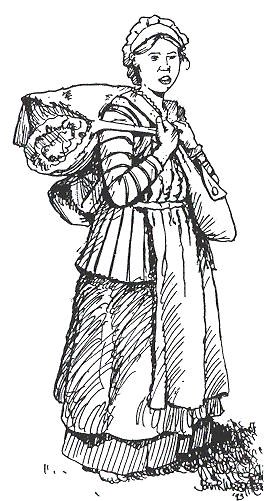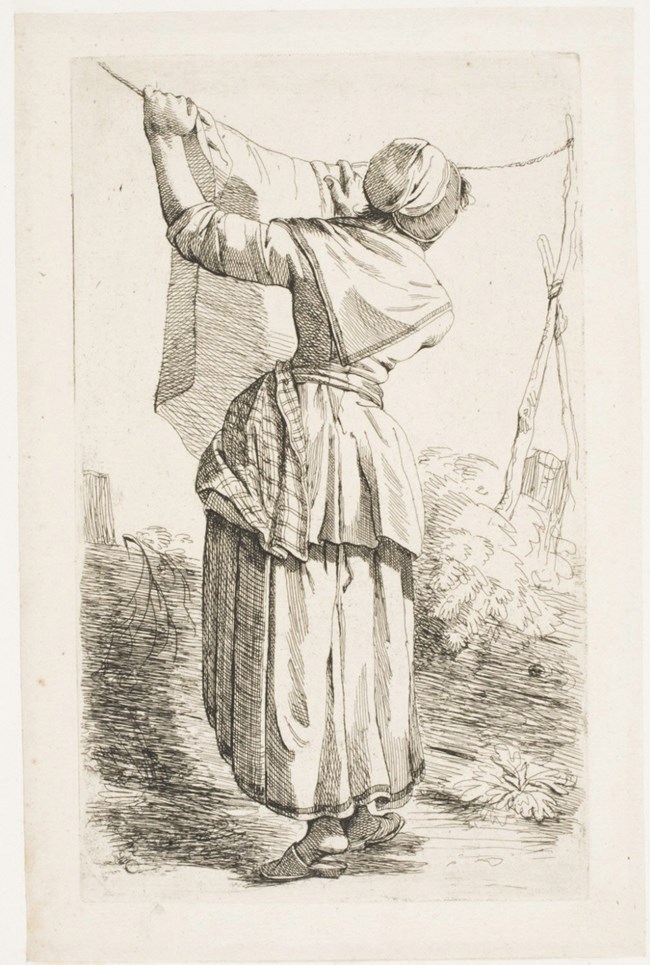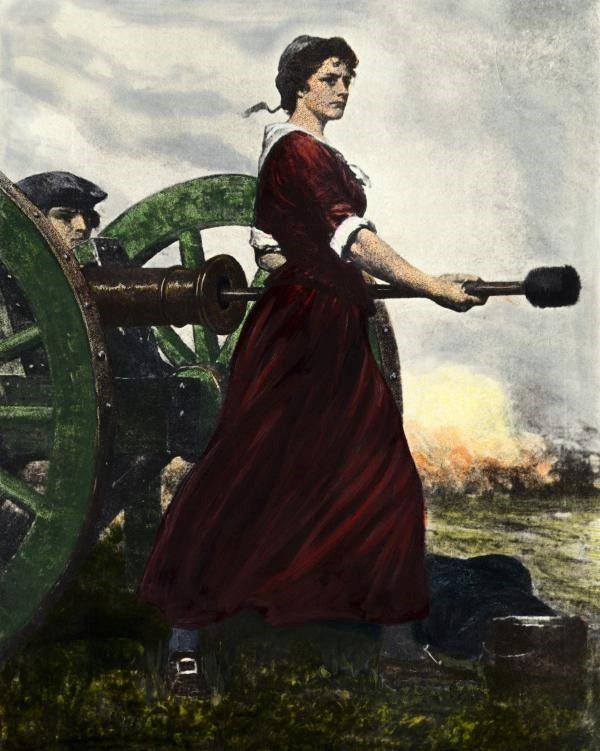Last updated: March 10, 2023
Article
Women of the Continental Army

Image by John R. Wright.
A great many women took part in the Revolutionary War. The two main reasons women usually followed their husbands into the army was the occupation and/or destruction of their home areas by the British, or they simply would not be able to provide for themselves and their families with their husband gone. This was most likely the case of many of the families of the New York soldiers that were at Fort Schuyler. Many of the soldiers had come from the New York City and lower Hudson Valley area, which was under British occupation and/or destroyed during the war. At Fort Schuyler there was little to no room inside the fort for families. Entries from various regimental orderly books indicate that families mostly lived in tents or huts down in the ditch outside the fort.
Initially, Officer’s wives were mostly visitors, as their husbands and/or families had the means to provide for them without them having to enter the military world. As the war progressed however, and the officers spent their fortunes and received no pay, those that did not want to resign were forced bring their families into the military setting. Captain Copp of the 1st New York Regiment had his wife with him at the fort in 1779. Captain Andrew Moody, commanding the artillery detachment at the fort in 1780-81 had both his wife and daughter living with him at the fort. It seems unlikely that anything other than absolute necessity would have induced these men to bring women and children into such a desolate, isolated and dangerous place.

Image circa 1790, from the Philadelphia Museum of Art
Women who traveled with the army had to work to be able to stay. In exchange for their work, the women received a ration of food (1/2 pound of meat and 1/2 pound of bread/flour). They were also supposed to be paid for their work, but with the soldiers hardly ever seeing proper pay, it’s unlikely that the women fared any better. These women had to follow many of the same orders and daily routines that the soldiers did. Women who fell into unsavory practices like prostitution or the unlicensed sale of goods could get punished with the Cat O' Nine Tails just like the soldiers. With few exceptions women also had to march along with the soldiers and carry all their belongings with them just as the soldiers did.
The usual work of women in the army was washing and mending the soldier's clothes (for every 50 or so soldiers at the fort, one woman would be assigned the work), and working as nurses in the hospitals. This is not the same sort of nursing we think of today, however. Since it was considered indecent for a woman to see a man naked in a public setting, 18th century nursing meant cleaning chamber pots, and changing bedding and blankets. Women cooked for their families, but it was only on rare occasions that they cooked for other soldiers. One such occasion involved Sarah Osborn, the wife of a soldier in the 1st New York Regiment at Yorktown in 1781. Because the soldiers were busy digging trenches and fortifications day and night, they did not always have time to cook their food. Sarah and some of the other ladies began cooking for the soldiers. In her pension deposition, Sarah stated that “Deponent’s [Sarah] husband was there throwing up entrenchments and deponent cooked and carried in beef, and bread, and coffee (in a gallon pot) to the soldiers in the entrenchment.” She further stated that on one such trip she: “…met General Washington, who asked her if she ‘was not afraid of the cannonballs?’.” She replied: “No, the bullets would not cheat the gallows” and that “It would not do for the men to fight and starve too.”

Painting by C.Y. Turner
Women whose husbands and fathers served on cannon crews hauled water to cool down and clean the cannon barrels and for the crew members to drink. These women were sometimes given the nickname of "Molly Pitcher" because they sometimes used pitchers to carry the water. Two of these women, Margaret Corbin and Mary Ludwig Hays, even helped serve on the cannon crews after their husbands were killed or wounded in battle. Corbin was wounded and received a soldier's pension. She is buried in West Point, NY.
While we have no record of woman being in battle at Fort Stanwix(Schuyler), women were there under combat conditions. Prior to the British siege of Fort Schuyler in 1777, Col. Gansevoort ordered that all women with children be sent down to German Flatts (modern Herkimer). From period journal entries, we know that at least two women stayed behind. One, a Mrs. Nancy McCarty (wife of Dennis) was pregnant, and no doubt one of the reasons the other lady stayed behind was to help take care of her. This was during the time when midwives rather than doctors, delivered babies. During the siege however, both women were wounded, which suggests that they were doing work for the garrison in addition to dealing with maternal issues. In the end, both women survived and Mrs. McCarty gave birth to a healthy baby girl as the siege was ending. While we can only be certain of these two women being inside the fort during the siege, secondary research done during the early 1900’s suggests their might have been as many as eight women in the garrison at the time of the siege.
Truly, without the efforts of these hidden women, many of the efforts of the Continental Army would be for not as they wouldn't have had the support to succeed. So the next time you visit an American Revolutionary War site, take a minute to "remember the ladies."
- Duration:
- 2 minutes, 7 seconds
What was life like for the "women of the army" who followed their husbands and fathers to Fort Stanwix, and how are they remembered?
